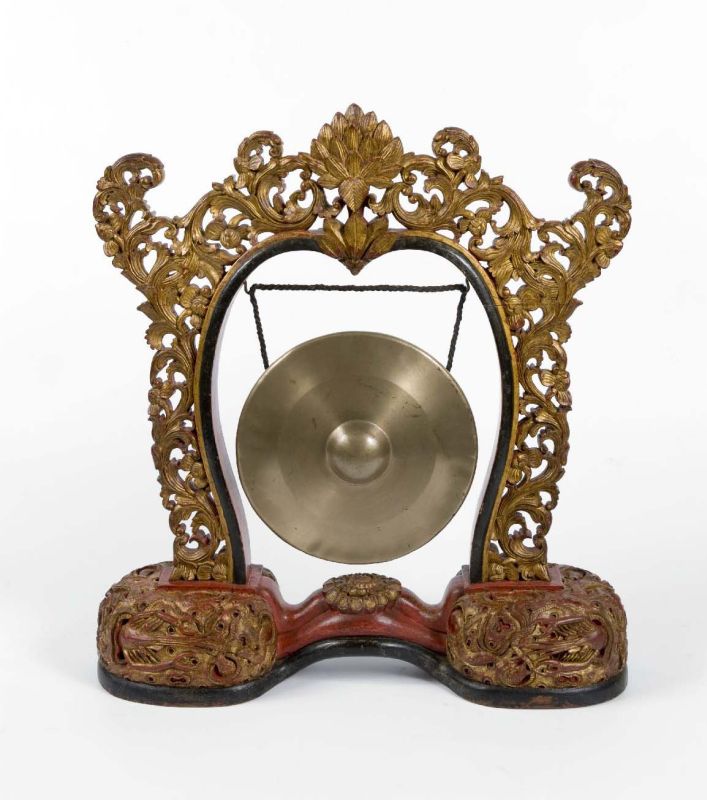|
Gandingan
The gandingan is a Philippine set of four large, hanging gongs used by the Maguindanao as part of their kulintang ensemble. When integrated into the ensemble, it functions as a secondary melodic instrument after the main melodic instrument, the kulintang. When played solo, the gandingan allows fellow Maguindanao to communicate with each other, allowing them to send messages or warnings via long distances. This ability to imitate tones of the Maguindanao language using this instrument has given the gandingan connotation: the “talking gongs.” Description The instrument is usually described as four, large, shallow-bossed, thin-rimmed gongs, vertically hung, either from a strong support such as a tree limb or housed in a strong wooden framed stand. The gongs are arranged in graduated fashion in pairs with knobs of the lower-pitched gongs facing each other and the higher-pitched gongs doing the same. Normally, the lower-pitched gongs would be situated on the left side and the ... [...More Info...] [...Related Items...] OR: [Wikipedia] [Google] [Baidu] |
Agung
The agung is a set of two wide-rimmed, vertically suspended gongs used by the Maguindanao, Maranao, Sama-Bajau and Tausug people of the Philippines as a supportive instrument in kulintang ensembles. The agung is also ubiquitous among other groups found in Palawan, Panay, Mindoro, Mindanao, Sabah, Sulawesi, Sarawak and Kalimantan as an integral part of the agung orchestra. Description The agung is a large, heavy, wide-rimmed gong shaped like a kettle gong. of the agung produces a bass sound in the kulintang orchestra and weighs between 13 and 16 pounds, but it is possible to find agungs weigh as low as 5 pounds or as high as 20 or 30 pounds each, depending on the metal (bronze, brass or iron) used to produce them. Though their diameters are smaller than the gandingan's, at roughly to in length, they have a much deeper turned-in ''takilidan'' (rim) than the latter, with a width of 12 to 13 inches (330 mm) including the knob.Cadar, Usopay H., and Robert Ga ... [...More Info...] [...Related Items...] OR: [Wikipedia] [Google] [Baidu] |
Kulintang
Kulintang (, ) is a modern term for an ancient instrumental form of music composed on a row of small, horizontally laid gongs that function melodically, accompanied by larger, suspended gongs and drums. As part of the larger gong-chime culture of Southeast Asia, kulintang music ensembles have been playing for many centuries in regions of the Mindanao, Southern Philippines, East Malaysia, Eastern Malaysia, Regions of Indonesia#Eastern Indonesia, Eastern Indonesia, Brunei and Timor, Kulintang evolved from a simple native signaling tradition, and developed into its present form with the incorporation of knobbed gongs from Sundanese people in Java Island, Indonesia. Its importance stems from its association with the indigenous cultures that inhabited these islands prior to the influences of Hinduism, Buddhism, Islam, Christianity or Western world, the West, making kulintang the most developed tradition of Southeast Asian archaic gong-chime ensembles. Technically, ''kulintang'' is t ... [...More Info...] [...Related Items...] OR: [Wikipedia] [Google] [Baidu] |
Gong
A gongFrom Indonesian language, Indonesian and ; ; zh, c=鑼, p=luó; ; ; ; ; is a percussion instrument originating from Southeast Asia, and used widely in Southeast Asian and East Asian musical traditions. Gongs are made of metal and are circular and flat or bowl-like in shape, and can come in various sizes. They are typically struck with a mallet. They can be played alone, giving a characteristic "crashing" sound, or played as part of a tuned set that produce bell-like sounds. The earliest possible depictions of gongs is from the details on the surface of the Ngọc Lũ I Dong son drum, bronze drum () from the Dong Son culture of northern Vietnam. It depicts what looks like seven-gong ensembles along with other instruments (including cymbals/bells and the bronze drums themselves). The oldest undisputed historical mention of gongs can be found in sixth century AD Chinese records, which mentioned it as a foreign instrument that came from a country between Tibet and Bur ... [...More Info...] [...Related Items...] OR: [Wikipedia] [Google] [Baidu] |
Gongs
A gongFrom Indonesian and ; ; zh, c=鑼, p=luó; ; ; ; ; is a percussion instrument originating from Southeast Asia, and used widely in Southeast Asian and East Asian musical traditions. Gongs are made of metal and are circular and flat or bowl-like in shape, and can come in various sizes. They are typically struck with a mallet. They can be played alone, giving a characteristic "crashing" sound, or played as part of a tuned set that produce bell-like sounds. The earliest possible depictions of gongs is from the details on the surface of the Ngọc Lũ I bronze drum () from the Dong Son culture of northern Vietnam. It depicts what looks like seven-gong ensembles along with other instruments (including cymbals/bells and the bronze drums themselves). The oldest undisputed historical mention of gongs can be found in sixth century AD Chinese records, which mentioned it as a foreign instrument that came from a country between Tibet and Burma. The term ''gong'' () origina ... [...More Info...] [...Related Items...] OR: [Wikipedia] [Google] [Baidu] |



